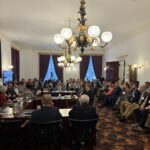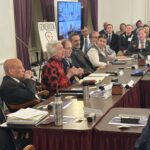Housing Bill Amendment Moves in the Wrong Direction
“Bureaucracy is the death of any achievement.” — Albert Einstein
Einstein’s warning feels especially relevant this week as legislative changes threaten to derail a key housing development tool when Vermont needs it most. As the state continues to grapple with a critical housing shortage impacting businesses and communities statewide, lawmakers focused on refining the Community and Housing Infrastructure Program (CHIP), the latest version of a targeted Tax Increment Financing (TIF) model that has been in development for five years. Designed to fund essential public infrastructure like water, sewer, and roads, CHIP is meant to unlock housing projects that would otherwise remain financially unfeasible. However, recent amendments have added layers of bureaucracy and limitations that risk stalling progress at a time when swift, effective action is essential.
The core principle of TIF is that the increase in property tax revenue generated by a new development (the “increment”) is used to repay the infrastructure bonds, leveraging future growth to finance necessary investments. Without this infrastructure, many housing developments cannot financially move forward meaning the new tax revenue wouldn’t exist anyway.
After the House Ways and Means Committee made sweeping changes to the CHIP proposal, a joint hearing was held by the House Commerce and Economic Development Committee and the House General and Housing Committee. Lawmakers who had spent weeks developing the Senate’s policy framework raised serious concerns, as the amendments appeared to create new barriers rather than improvements.
According to Ways and Means, the changes were intended to provide “reasonable guardrails” on the use of education property tax increment. In practice, the added provisions are more restrictive than protective. Key changes include:
- Housing Percentage Requirement: Mandates 65% of a project’s floor area be housing, limiting flexibility for rural or adaptive reuse projects.
- Education Tax Retention Rate: Lowers the retention rate from 75% to 60%, with an optional 80% for deeply income-restricted housing, raising viability concerns.
- $40 Million Cap: Imposes a total annual cap that may disadvantage under-resourced as well as large communities and limit program impact during a housing crisis.
- “But-For” Test: Requires developers to prove projects wouldn’t proceed without the incentive, adding new hoops to jump through during a well-documented housing crisis.
- Sunset Date: Introduces a 2028 end date for the standard TIF program without policy committee discussion, creating long-term uncertainty to an established economic development tool.
The Vermont Chamber is deeply disappointed in the direction this bill has taken. The House Ways and Means Committee’s amendments undermine a carefully negotiated policy intended to spur urgently needed housing in communities struggling with affordability. Rather than advancing a tool to meet the scale of Vermont’s affordability and development crisis, the proposal now adds delay, complexity, and uncertainty. In the remaining two weeks of the session, the Vermont Chamber urges legislators to work collaboratively to move this proposal back into a form that meets the moment—with bold, flexible solutions that support all communities in building desperately needed infrastructure that will support all types of housing.














